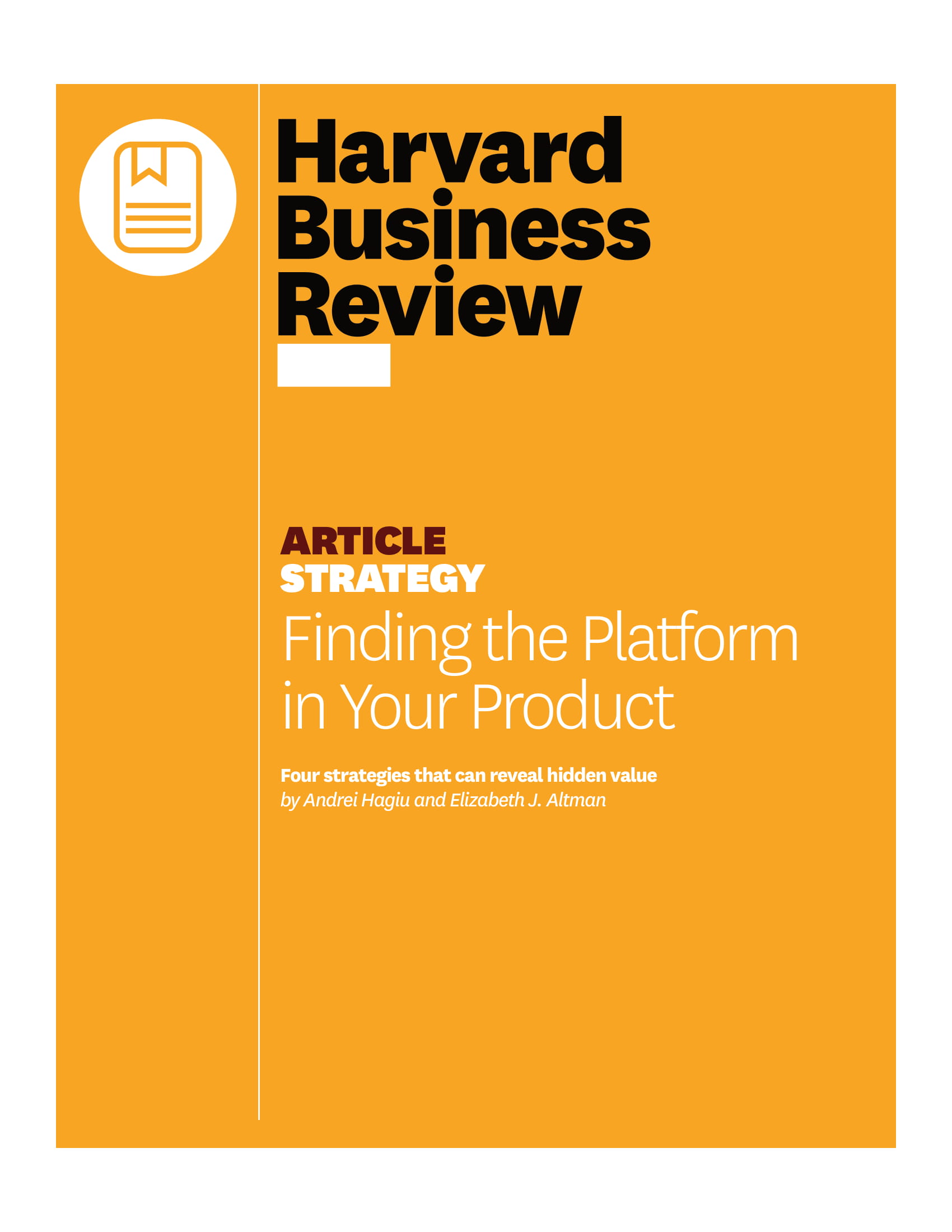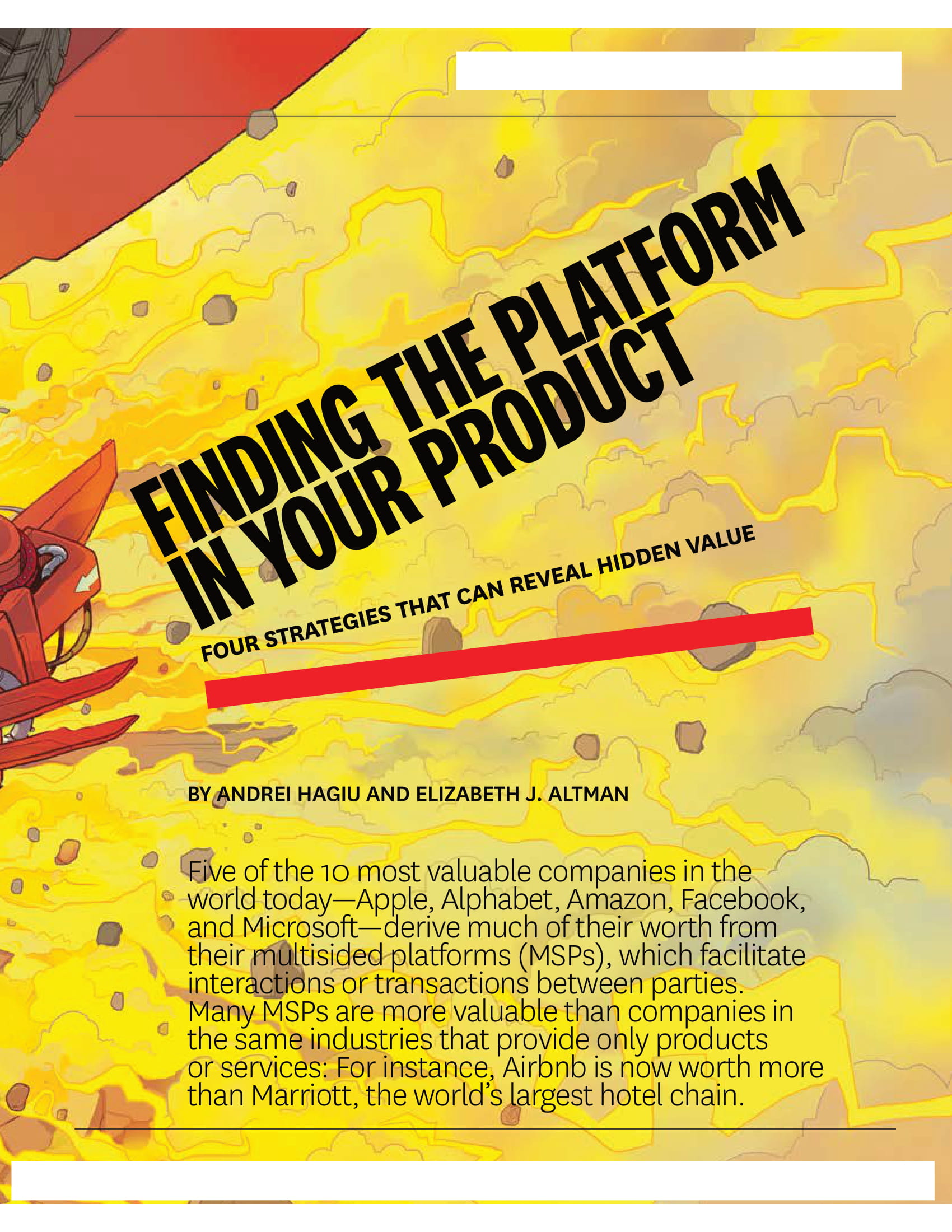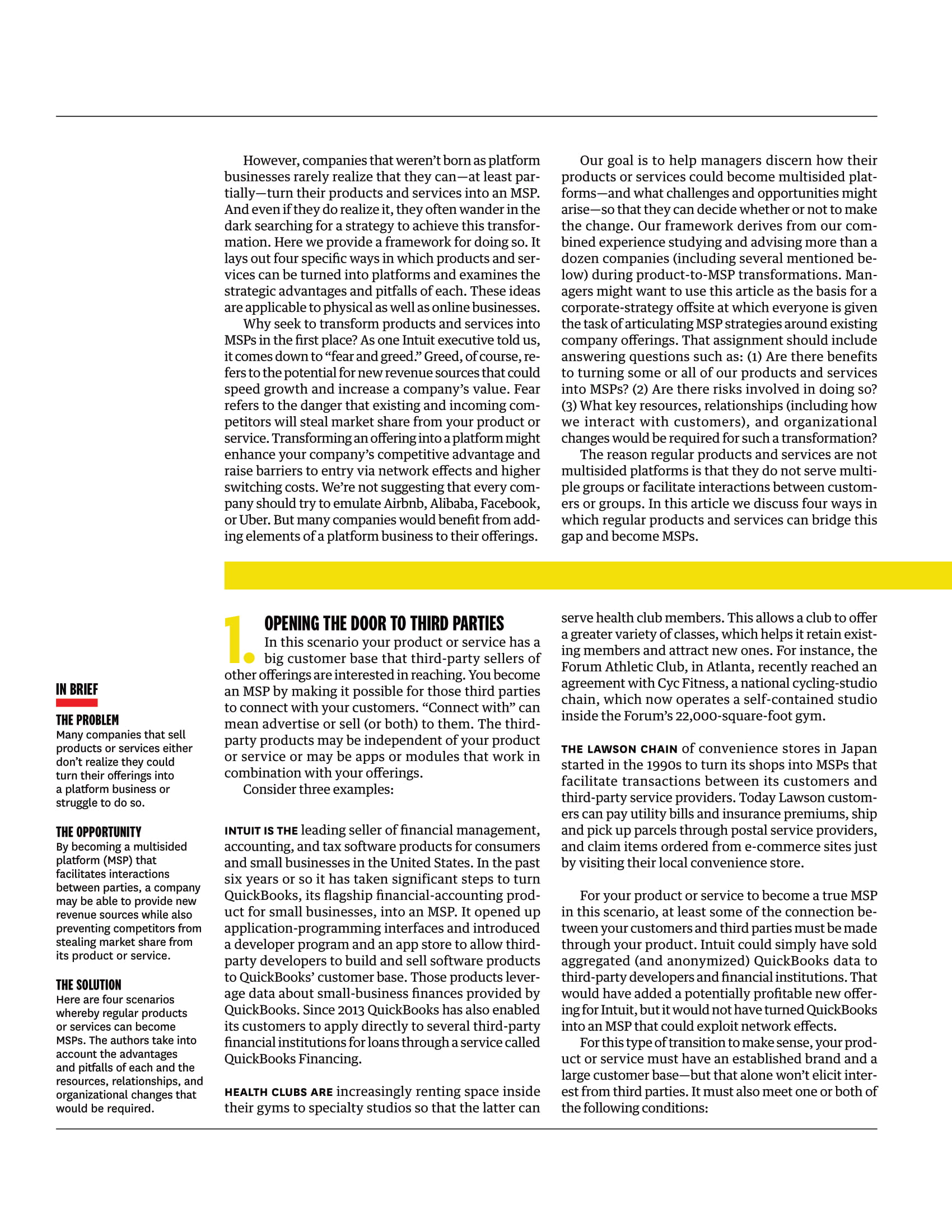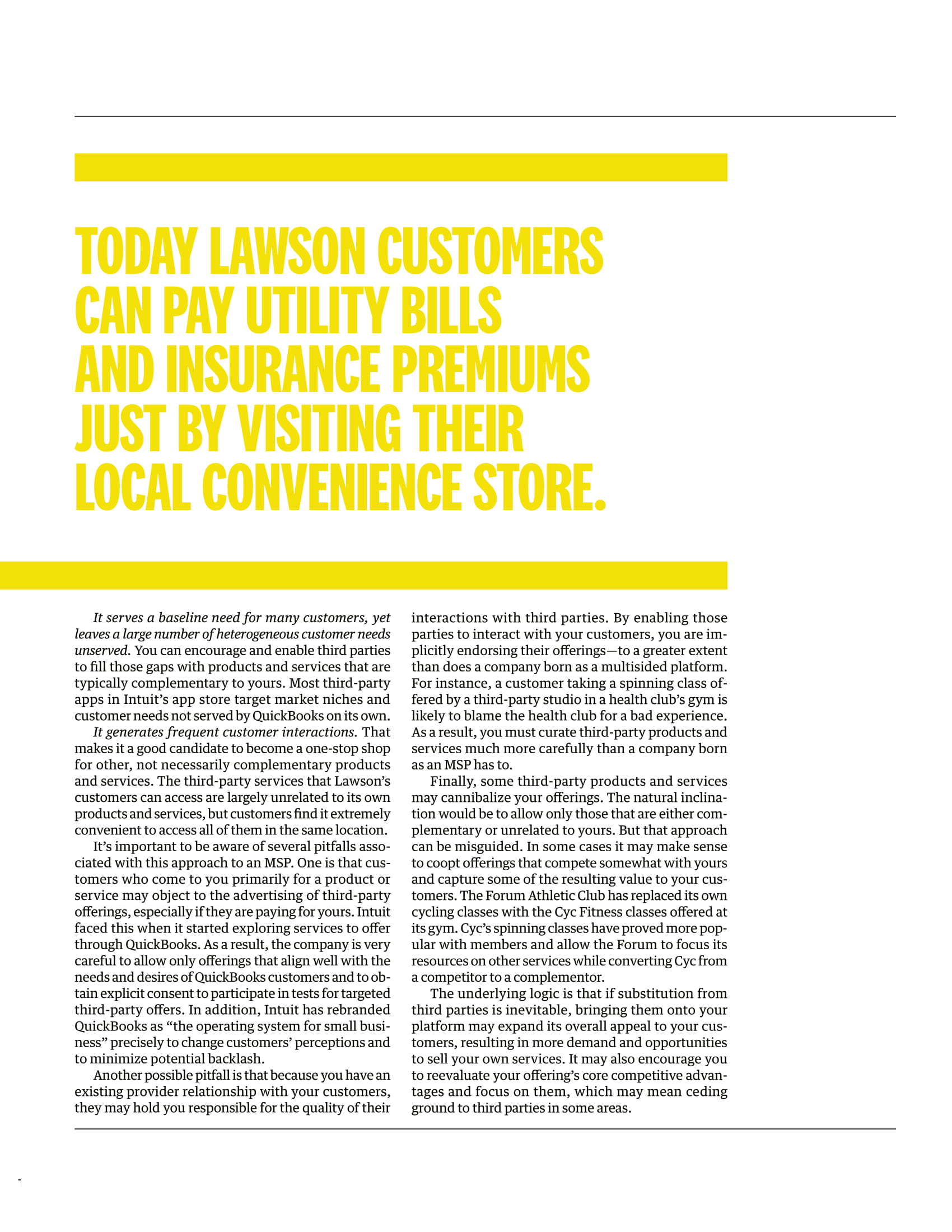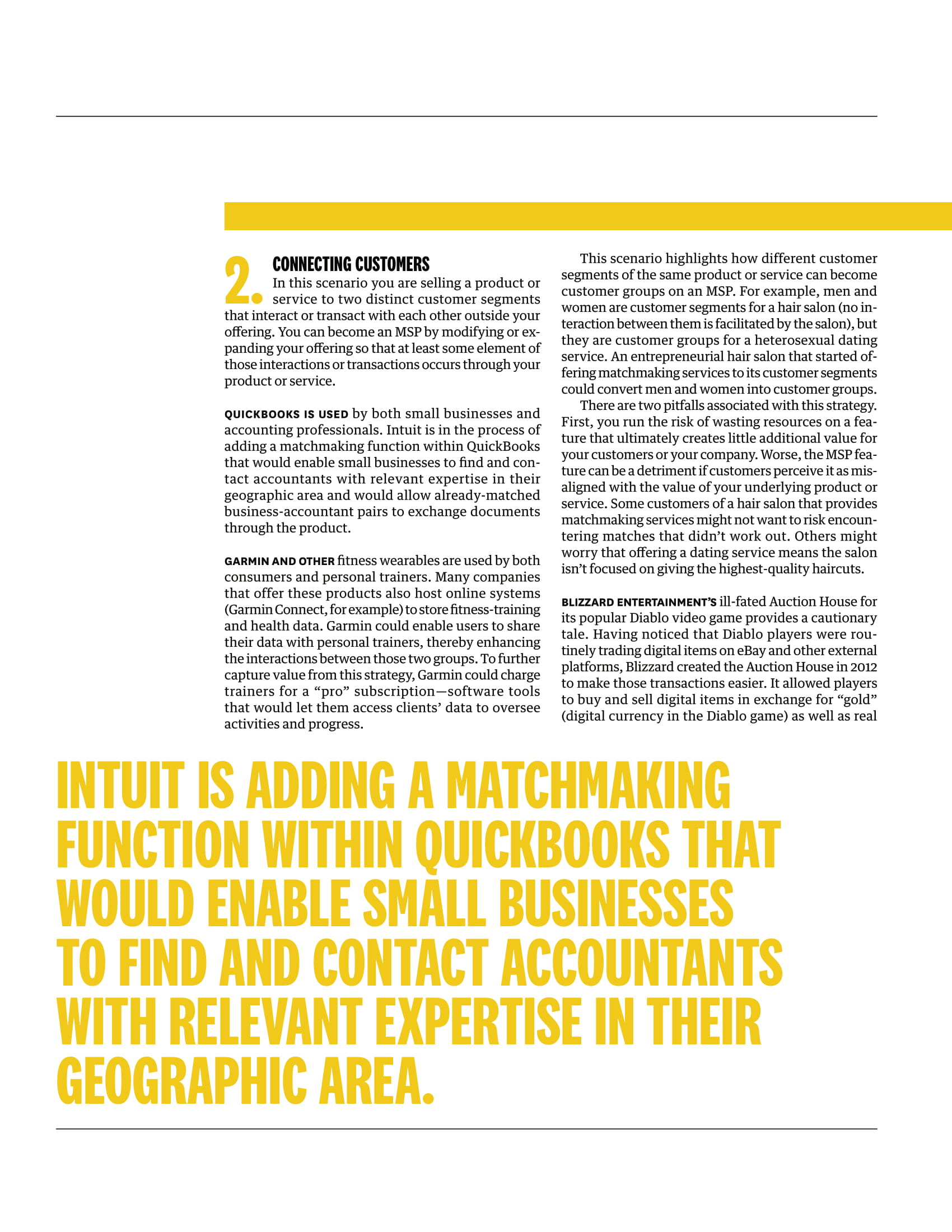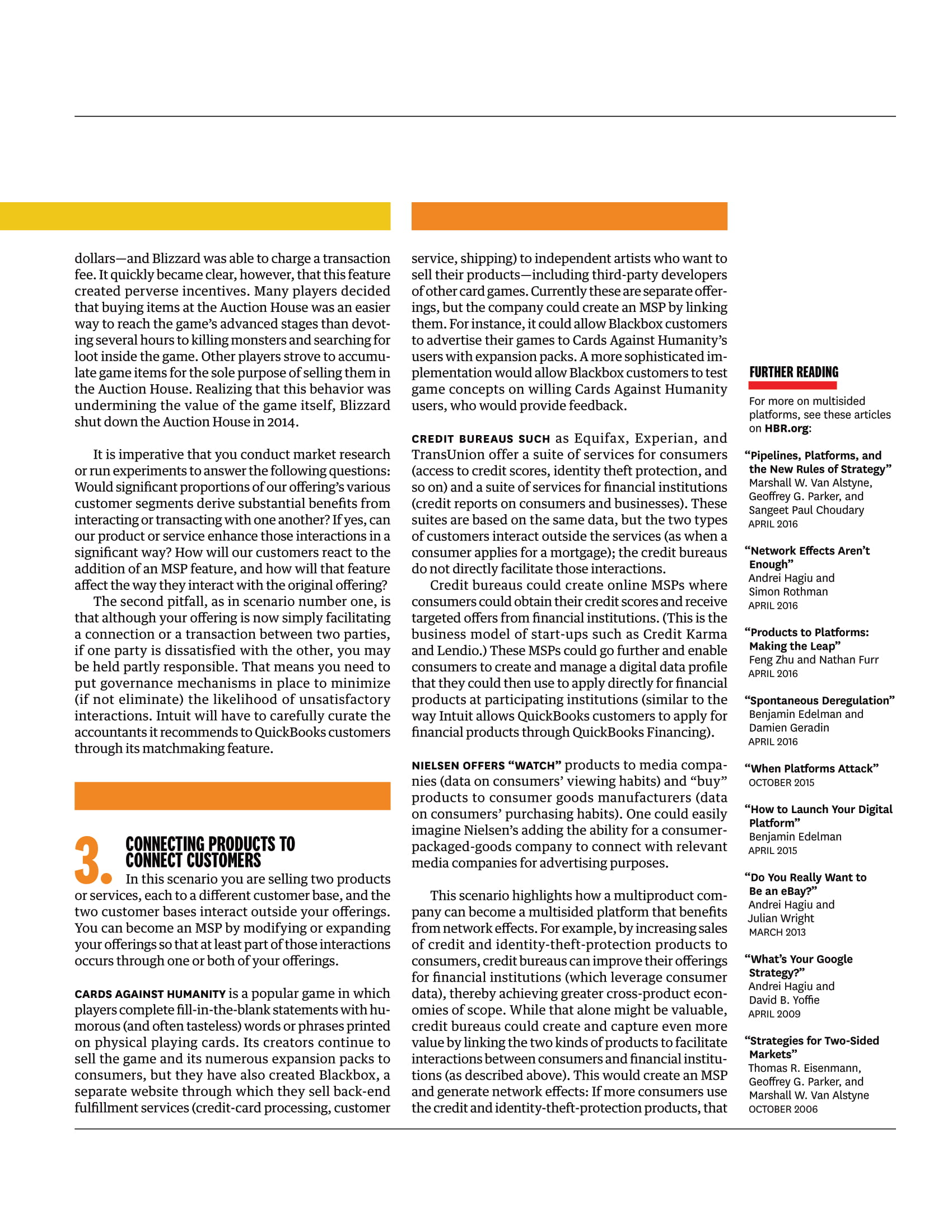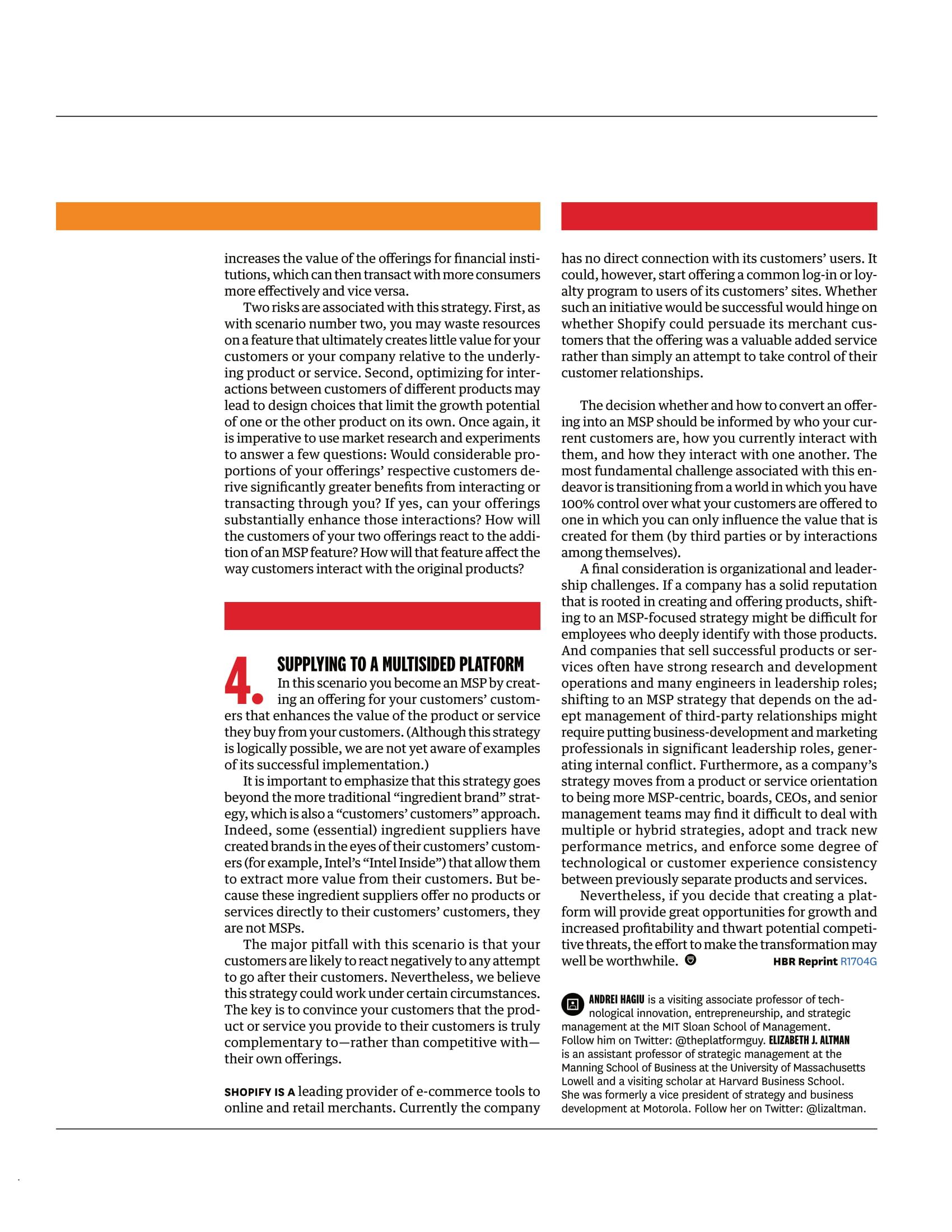summary for this article :key theme, major findings, and key implications
Harvard Business Review ARTICLE STRATEGY Finding the Platform in Your Product Four strategies that can reveal hidden value by Andrei Hagiu and Elizabeth J. Altman\fFINDING THE PLATFORM IN YOUR PRODUCT FOUR STRATEGIES THAT CAN REVEAL HIDDEN VALUE BY ANDREI HAGIU AND ELIZABETH J. ALTMAN Five of the 10 most valuable companies in the world today-Apple, Alphabet, Amazon, Facebook, and Microsoft-derive much of their worth from their multisided platforms (MSPS), which facilitate interactions or transactions between parties. Many MSPs are more valuable than companies in the same industries that provide only products or services: For instance, Airbnb is now worth more than Marriott, the world's largest hotel chain.TNE PIIIIILEII Many companies that sell products or services either don't realize they could turn their offerings into a platform business or struggle to do so. TNE OPPORTUNITY By becoming a multisided platform (MSP) that facilitates interactions between parties, a company may be able to provide new revenue sources while also preventing competitors from stealing market share from its product or service. TNE Slll'IIIIN Here are four scenarios whereby regular products or services can become MSPs. The authors take into account the advantages and pitfalls of each and the resources, relationships. and organizational changes that would be required. However, companies that weren't born as platform businesses rarely realize that they can-at least par- tiallyturn their products and services into art MSP. And even if they do realize it, they often wander in the dark searching for a strategy to achieve this transfor- mation. Here we provide a framework for doing so. It lays out four specic ways in which products and ser- vices can be turned into platforms and examines the strategic advantages and pitfalls of each. These ideas are applicable to physical as well as online businesses. Why seek to transform products and services into MSPs in the rst place? As one Intuit executive told us, it comes down to \"fear and greed.\" Greed, of course, re- fers to the potential for new revenue sources that could speed growth and increase a company's value. Fear refers to the danger that existing and incoming com- petitors will steal market share from your product or service. Transfomiingan offering into aplatfom'i might enhance your company's competitive advantage and raise barriers to entry via network effects and higher switching costs. We're not suggesting that every com pany should try to emulate Airbnb, Alibaba, Facebook, or Uber. But many companies would benet from add- ing elements of a platform business to their offerings. OPENING THE DOOR T0 THIIIII PARTIES In this scenario your product or service has a big customer base that thirdparty sellers of other offering are interested in reaching. You become an MSP by making it possible for those third parties to connect with your customers. \"Connect with\" can mean advertise or sell (or both) to them. The third- party products may be independent of your product or service or may be apps or modules that work in combination with your offerings. Consider three examples: INTUIT Is THE leading seller of nancial management, accounting, and tax software products for consumers and small businesses in the United States. In the past six years or so it has taken significant steps to turn QuickBooks, its agship nancial-accounting prod- uct for small businesses, into an MSP. It opened up application-programming interfaces and introduced a developer program and an app store to allow third- party developers to build and sell software products to QuickBooks' customer base. Those products lever- age data about small-business nances provided by QuickBooks. Since 2013 QuickBooks has also enabled its customers to apply directly to several third-party nancial institutions for loans through a service called QuickBooks Financing. HEALTH owes me increasingly renting space inside their gyms to specialty studios so that the latter can Our goal is to help managers discern how their products or services could become multisided plat- formsand what challenges and opportunities might ariseso that they can decide whether or not to make the change. Our framework derives from our com- bined experience studying and advising more than a dozen companies (including several mentioned be- low) during product-to-MSP transformations. Man- agers might want to use this article as the basis for a corporate-strategy offsite at which everyone is given the task of articulating MSP strategies around existing company offerings. That assignment should include answering questions such as: (1) Are there benefits to turning some or all of our products and services into MSPs? (2) Are there risks involved in doing so? (3) What key resources, relationships (including how we interact with customers), and organizational changes would be required for such a transformation? The reason regular products and services are not multisided platforms is that they do not serve multi ple groups or facilitate interactions between custom- ers or groups. In this article we discuss four ways in which regular products and services can bridge this gap and become MSPs. serve health club members. This allows a club to offer a greater variety of classes, which helps it retain exist- ing members and attract new ones. For instance, the Forum Athletic Club, in Atlanta, recently reached an agreement with Cyc Fitness, 3 national cycling-studio chain, which now operates a self-contained studio inside the Forum's 22,000-square-foot gym. THE LAWSON CHAIN of convenience stores in Japan started in the 19905 to turn its shops into MSPs that facilitate transactions between its customers and third-party service providers. Today Lawson custom- ers can pay utility bills and insurance premiums, ship and pick up parcels through postal service providers, and claim items ordered from e-commerce sites just by visiting their local convenience store. For your product or service to become a true MSP in this scenario, at least some of the connection be- tween your customers and third parties must be made through your product. Intuit could simply have sold aggregated (and anonymized) QuickBooks data to third-party developers and nancial institutions. That would have added a potentially protable new offer- ingfor Intuit, but it would not have turned QuickBooks into an MSP that could exploit network effects. For this type of transition to make sense, your prod- uct or service must have an established brand and a large customer basebut that alone won't elicit inter- est from third parties. It must also meet one or both of the following conditions: It serves a baseline need for many customers, yet leaves a large number of heterogeneous customer needs unserved. You can encourage and enable third parties to ll those gaps with products and services that are typically complementary to yours. Most thirdparty apps in Intuit's app store target market niches and customer needs not served by QuickBooks on its own. It generates frequent customer interactions. That makes it a good candidate to become a one-stop shop for other, not necessarily complementary products and services. The thirdparty services that Lawson's customers can access are largely unrelated to its own products and services, but customers nd it extremely convenient to access all of them in the same location. It's important to be aware of several pitfalls asso- ciated with this approach to an MSP. One is that cus tomers who come to you primarily for a product or service may object to the advertising of third-party offerings, especially if they are paying for yours. Intuit faced this when it started exploring services to offer through QuickBooks. As a result, the company is very careful to allow only offerings that align well with the needs and desires of QuickBooks customers and to ob- tain explicit consent to participate in tests for targeted third-party offers. In addition, Intuit has rebranded QuickBooks as \"the operating system for small busi- ness\" precisely to change customers' perceptions and to minimize potential backlash. Another possible pitfall is that because you have an existing provider relationship with your customers, they may hold you responsible for the quality of their interactions with third parties. By enabling those parties to interact with your customers, you are im- plicitly endorsing their offerings to a greater extent than does a company born as a multisided platform. For instance, a customer taking a spinning class of fered by a third-party studio in a health club's gym is likely to blame the health club for a bad experience. As a result, you must curate third-party products and services much more carefully than a company born as an MSP has to. Finally, some thirdparty products and services may cannibalize your o'erings. The natural inclina- tion would be to allow only those that are either com- plementary or unrelated to yours. But that approach can be misguided. In some cases it may make sense to coopt offerings that compete somewhat with yours and capture some of the resulting value to your cus tomers. The Forum Athletic Club has replaced its own cycling classes with the Cyc Fitness classes offered at its gym. Cyc's spinning classes have proved more pop- ular with members and allow the Forum to focus its resources on other services while converting Cyc from a competitor to a complementor. The underlying logic is that if substitution from third parties is inevitable, bringing them onto your platform may expand its overall appeal to your cus- tomers, resulting in more demand and opportunities to sell your own services. It may also encourage you to reevaluate your o'ering's core competitive advan- tages and focus on them, which may mean ceding ground to third parties in some areas. CONNECTING CUSTOIIERS In this scenario you are selling a product or 0 service to two distinct customer segments that interact or transact with each other outside your oering. You can become an MSP by modifying or ex- panding your offering so that at least some element of those interactions or transactions occurs through your product or service. ourcxeoorrs Is user: by both small businesses and accounting professionals. Intuit is in the process of adding a matchmaking function within QuickBooks that would enable small businesses to nd and con- tact accountants with relevant expertise in their geographic area and would allow already-matched business-accountant pairs to exchange documents through the product. GARMIN nun omen tness wearables are used byboth consumers and personal trainers. Many companies that offer these products also host online systems (Garmin Connect, for example) to store tness-training and health data. Garmin could enable users to share their data with personal trainers, thereby enhancing the interactions between those two groups. To further capture value from this strategy, Garmin could charge trainers for a \"pro" subscriptionsoftware tools that would let them access clients' data to oversee activities and progress. This scenario highlights how different customer segments of the same product or service can become customer groups on an MSP. For example, men and women are customer segments for a hair salon (no in- teraction between them is facilitated by the salon), but they are customer groups for a heterosexual dating service. An entrepreneurial hair salon that started of- fering matchmaking services to its customer segments could convert men and women into customer groups. There are two pitfalls associated with this strategy. First, you run the risk of wasting resources on a fea- ture that ultimately creates little additional value for your customers or your company. Worse, the MSP fea- ture can be a detriment if customers perceive it as mis aligned with the value of your underlying product or service. Some customers of a hair salon that provides matchmaking services might not want to risk encoun- tering matches that didn't work out. Others might worry that offering a dating service means the salon isn't focused on giving the highestquality haircuts. BLIZZARD ENTERTAINMENT'S ill-fated Auction House for its popular Diablo video game provides a cautionary tale. Having noticed that Diablo players were rou- tinely trading digital items on eBay and other external platforms, Blizzard created the Auction House in 2012 to make those transactions easier. It allowed players to buy and sell digital items in exchange for \"gold\" (digital currency in the Diablo game) as well as real INTUIT IS ADDING A MATCHMANING FUNCTION WITHIN QUICNBOONS THAT WOULD ENABLE SMALL BUSINESSES TO FIND AND CONTACT ACCOUNTANTS WITH RELEVANT EXPERTISE IN THEIR GEOGRAPHIC AREA. dollars-and Blizzard was able to charge a transaction fee. It quickly became clear, however, that this feature service, shipping) to independent artists who want to sell their products-including third-party developers created perverse incentives. Many players decided of other card games. Currently these are separate offer- that buying items at the Auction House was an easier ings, but the company could create an MSP by linking way to reach the game's advanced stages than devot- them. For instance, it could allow Blackbox customers ing several hours to killing monsters and searching for to advertise their games to Cards Against Humanity's loot inside the game. Other players strove to accumu- users with expansion packs. A more sophisticated im- late game items for the sole purpose of selling them in plementation would allow Blackbox customers to test FURTHER READING the Auction House. Realizing that this behavior was game concepts on willing Cards Against Humanity undermining the value of the game itself, Blizzard users, who would provide feedback. For more on multisided shut down the Auction House in 2014. platforms, see these articles CREDIT BUREAUS SUCH as Equifax, Experian, and on HBR.org: It is imperative that you conduct market research TransUnion offer a suite of services for consumers "pipelines, Platforms, and or run experiments to answer the following questions: (access to credit scores, identity theft protection, and the New Rules of Strategy" Would significant proportions of our offering's various so on) and a suite of services for financial institutions Marshall W. Van Alstyne customer segments derive substantial benefits from (credit reports on consumers and businesses). These Geoffrey G. Parker, an interacting or transacting with one another? If yes, can suites are based on the same data, but the two types Sangeet Paul Choudary our product or service enhance those interactions in a of customers interact outside the services (as when a APRIL 2016 significant way? How will our customers react to the consumer applies for a mortgage); the credit bureaus "Network Effects Aren't addition of an MSP feature, and how will that feature do not directly facilitate those interaction Enough" affect the way they interact with the original offering? Credit bureaus could create online MSPs where Andrei Hagiu and The second pitfall, as in scenario number one, is consumers could obtain their credit scores and receive Simon Rothman APRIL 2016 that although your offering is now simply facilitating targeted offers from financial institutions. (This is the a connection or a transaction between two parties, business model of start-ups such as Credit Karma "Products to Platforms: if one party is dissatisfied with the other, you may and Lendio.) These MSPs could go further and enable Making the Leap" be held partly responsible. That means you need to consumers to create and manage a digital data profile Feng Zhu and Nathan Furr put governance mechanisms in place to minimize that they could then use to apply directly for financial APRIL 2016 if not eliminate) the likelihood of unsatisfactory products at participating institutions (similar to the "Spontaneous Deregulation" interactions. Intuit will have to carefully curate the way Intuit allows QuickBooks customers to apply for Benjamin Edelman and accountants it recommends to QuickBooks customers financial products through QuickBooks Financing). Damien Geradin through its matchmaking feature. APRIL 2016 NIELSEN OFFERS "WATCH" products to media compa- nies (data on consumers' viewing habits) and "buy" "When Platforms Attack" OCTOBER 2015 products to consumer goods manufacturers (data on consumers' purchasing habits). One could easily "How to Launch Your Digital imagine Nielsen's adding the ability for a consumer- Platform" 3. CONNECTING PRODUCTS TO Benjamin Edelman CONNECT CUSTOMERS packaged-goods company to connect with relevant APRIL 2015 media companies for advertising purposes. In this scenario you are selling two products "Do You Really Want to or services, each to a different customer base, and the This scenario highlights how a multiproduct com- Be an eBay?' two customer bases interact outside your offerings. pany can become a multisided platform that benefits Andrei Hagiu and You can become an MSP by modifying or expanding from network effects. For example, by increasing sales Julian Wright your offerings so that at least part of those interactions MARCH 2013 of credit and identity-theft-protection products to occurs through one or both of your offerings. consumers, credit bureaus can improve their offerings "What's Your Google CARDS AGAINST HUMANITY is a popular game in which for financial institutions (which leverage consumer Strategy?" data), thereby achieving greater cross-product econ- Andrei Hagiu and players complete fill-in-the-blank statements with hu- omies of scope. While that alone might be valuable, David B. Yoffie APRIL 2009 morous (and often tasteless) words or phrases printed credit bureaus could create and capture even more on physical playing cards. Its creators continue to value by linking the two kinds of products to facilitate "Strategies for Two-Sided sell the game and its numerous expansion packs to interactions between consumers and financial institu- Markets" consumers, but they have also created Blackbox, a tions (as described above). This would create an MSP Thomas R. Eisenmann, separate website through which they sell back-end fulfillment services (credit-card processing, customer and generate network effects: If more consumers use Geoffrey G. Parker, and the credit and identity-theft-protection products, that Marshall W. Van Alstyne OCTOBER 2006increases the value of the offerings for nancial insti- tutions, which can then transact with more consumers more effectively and vice versa. Two risks are associated with this strategy. First, as with scenario number two, you may waste resources on a feature that ultimately creates little value for your customers or your company relative to the underly- ing product or service. Second, optimizing for inter- actions hetween customers of different products may lead to design choices that limit the growth potential of one or the other product on its own. Once again, it is imperative to use market research and experiments to answer a few questions: Would considerable pro- portions of your offerings' respective customers de rive signicantly greater benets from interacting or transacting through you? If yes, can your offerings substantially enhance those interactions? How will the customers of your two offerings react to the addi- tion of an MSP feature? How will that feature affect the way customers interact with the original products? SlIPPlYING T0 ll HIIITISIIIEII PLATFORM In this scenario you become an MSP by creat . ing an offering for your customers' custom ers that enhances the value of the product or service they buy from your customers. (Although this strategy is logically possible, we are not yet aware of examples of its successful implementation.) It is important to emphasize that this strategy goes beyond the more traditional \"ingredient bran \" strat egy, which is also a \"customers' customers" approach. Indeed, some (essential) ingredient suppliers have created brands in the eyes of their customers' custom- ers (for example, Intel's \"Intel Inside\") that allow them to extract more value from their customers. But be- cause these ingredient suppliers offer no products or services directly to their customers' customers, they are not MSPs . The major pitfall with this scenario is that your customers are likely to react negatively to any attempt to go after their customers. Nevertheless, we believe this strategy could work under certain circumstances. The key is to convince your customers that the prod- uct or service you provide to their customers is truly complementary torather than competitive with- their own offerings. snoprav Is A leading provider of e-commerce tools to online and retail merchants. Currently the company has no direct connection with its customers' users. It could, however, start offering a common log-in or loy- alty program to users of its customers' sites. Whether such an initiative would be successful would hinge on whether Shopify could persuade its merchant cus- tomers that the offering was a valuable added service rather than simply an attempt to take control of their customer relationships. The decision whether and how to convert an offer- ing into an MSP should be informed by who your cur- rent customers are, how you currently interact with them, and how they interact with one another. The most fundamental challenge associated with this en deavor is transitioning from a world in which you have 100% control over what your customers are offered to one in which you can only inuence the value that is created for them (by third parties or by interactions among themselves). A nal consideration is organizational and leader ship challenges. If a company has a solid reputation that is rooted in creating and offering products, shift- ing to an MSP-focused strategy might be difcult for employees who deeply identify with those products. And companies that sell successful products or ser- vices often have strong research and development operations and many engineers in leadership roles; shifting to an MSP strategy that depends on the ad- ept management of third-party relationships might require putting business-development and marketing professionals in significant leadership roles, gener- ating internal conict. Furthermore, as a company's strategy moves from a product or service orientation to being more MSP-centric, boards, CEOs, and senior management teams may nd it diicult to deal with multiple or hybrid strategies, adopt and track new performance metrics, and enforce some degree of technological or customer experience consistency between previously separate products and services. Nevertheless, if you decide that creating a plat- form will provide great opportunities for growth and increased protability and thwart potential competi- tive threats, the effort to make the transformation may well be worthwhile. 6 Han Reprint nr7o4o IIIIIIIEI llliilll is a visiting associate professor of tech nological innovation, entrepreneurship, and strategic management at the MIT Sloan School of Management. Follow him on Twitter: @theplatformguy. lm I. All!\" is an assistant professor of strategic management at the Manning School of Business at the University of Massachusetts Lowell and a visiting scholar at Harvard Business School. She was formerly a vice president of strategy and business development at Motorola. Follow her on Twitter: @lizaltman
